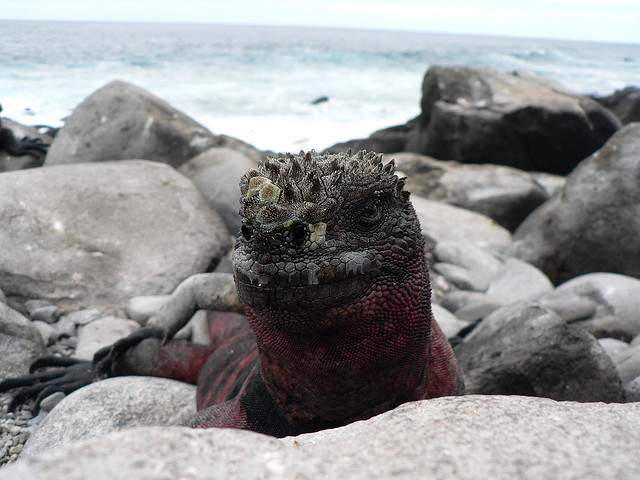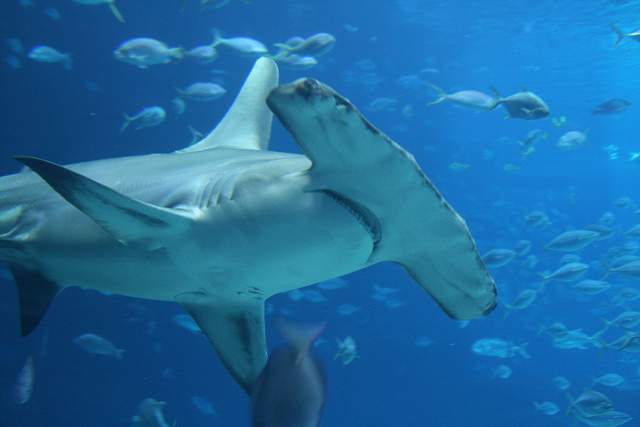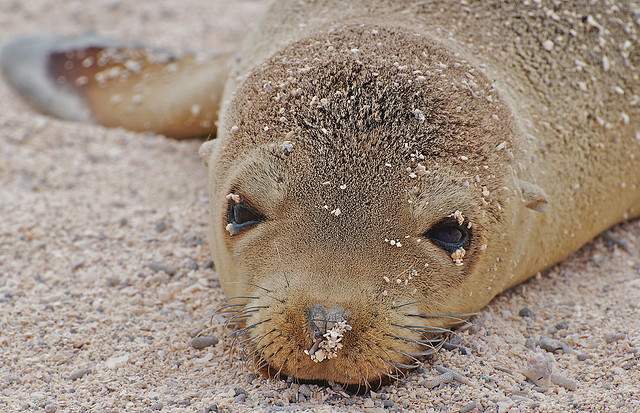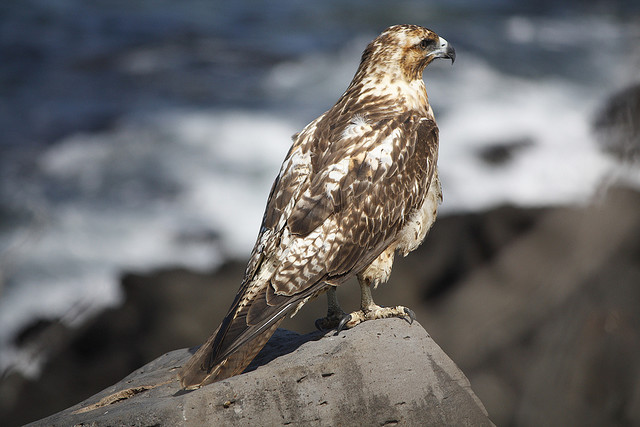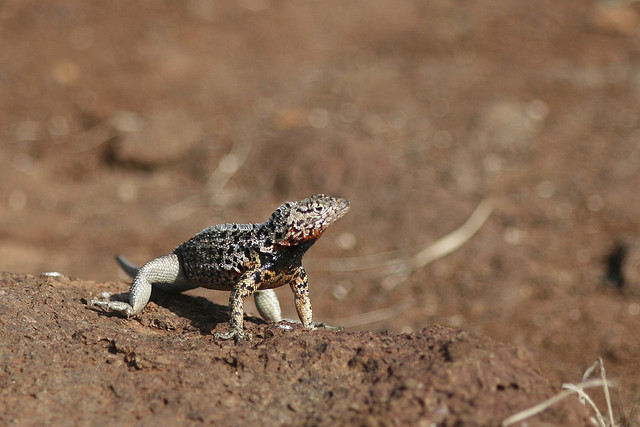When Charles Darwin hopped aboard the HMS beagle Bound for the Galapagos Islands and took the first official Galapagos Cruise between the years 1831 and 1836, he had no idea the myriad of weird and wild wonders he was about to encounter once he reached the Islands. The Archipelago that makes up the Galapagos Island chain is composed of 15 major Islands, 3 minor ones, and over a hundred smaller coastal rocks…all teeming with some of the strangest looking life you will find on the face of the earth.
Galapagos Island Marine Iguana
The Galapagos Island marine iguana is the only iguana found on the face of the earth that swims in the ocean. These reptiles (which are completely endemic to the Galapagos Island) have a characteristic brownish to grayish color and are frequently found swimming off the coast of in all the major Galapagos Islands. Garishly sporting a “Salt Whig” between their eyes on the top of the top of their head as a result of their incessant swimming in the sea, the Galapagos Marine Iguana has come to symbolize the islands and the “one of a kind “ variety of animals there. Being a traditional cold-blooded animal, the Galapagos Marine iguana is unable to withstand long periods in the water and must frequently maintain its body temperature while sunning itself on the rocks. A must see for any Galapagos traveler.
Hammerhead Sharks
Hammerhead Sharks are extremely common in the coastal waters of the Galapagos, sometimes found swimming in large shoals numbering in the hundreds. These unique and bizarre looking sharks are fearsome fish that are renowned for their mystique predatory nature, and any Marine diver who has come face to face with a pod of these pack hunters will personally attest to the fear that an up close and personal encounter can produce. Anyone interested in diving while visiting the Galapagos Islands is highly likely to come face to fin with these majestic swimmers in the waters off the coast of the Galapagos Islands. Like all sharks, the Galapagos Island hammerheads have no swim bladder to regulate their buoyancy, which necessitates the need for them to be in constant movement eternally searching for prey with their evolved sense for detecting electrical current in the body of their prey that reside in waters of the Galapagos.
Galapagos Islands Sea Lions
Sea Lions are a common sight on all the islands of the Galapagos, and in some parts of Ecuador as well. This particular species of sea lion is native to the Galapagos and exclusively breeds on the island themselves, they can be found crowding the beaches and the rocks off the coast of every islands in the Archipelago chain, sunning themselves and constantly barking at tourists and fishermen, alerting them to their presence. Like all sea lions, the Galapagos variety can be quite prickly when confronted and cornered, and they are known for lacking any semblance of modesty, nipping at fishermen and stealing their catches. Galapagos Island Sea Lions are popularly referred to as the welcoming party of the archipelago, greeting boats and cruise vessels full of incoming tourists as they traveled to this exotic destination.<
Galapagos Hawk
The Galapagos Hawk is a large bird of prey that is traditionally native to the Galapagos Islands. The Galapagos hawk is reputed to be over 300,000 years old evolutionarily speaking, and it is well known as the only original predator to still inhabit the Galapagos Islands. These particular birds of prey can have a wingspan of 2 to 3 feet, and are known to be fearless and not intimidated by tourists and people. You’ll regularly see them in the sky over Isla Isabella, searching for Galapagos finches, lizards, snakes, mice and any unlucky inhabitant of the Galapagos Islands that the Galapagos hawk calls “food”.
Galapagos Finches
The Galapagos finches are famous one of the main areas of study for Charles Darwin’s his theory of evolutionary biology. By studying the the size and the shape of the beaks of these captivating animals Charles, Darwin was able to deduce his theory of natural selection through selective breeding. There are at least 13 known types of Galapagos finches that inhabit the islands, and they are a common sight when visiting the destination. Galápagos finches are known to be brash and sociable when coming up to tourists, often eating out of their hands. You will see many of these social birds when traveling to the Galapagos, and you wouldn’t want to miss them.
Lava Lizards
Lava lizards are another type of reptile that is found on the Galapagos Islands, ostensibly named because of their bright red coloration. They can be found hopping about the rocks of the Galapagos Islands avoiding Galapagos hawks and sunning themselves to maintain their consistently fluctuating and volatile reptile internal body temperature. There are seven different species of these interesting little animals, all of which are endemic to the Galapagos…and all equally fascinating.
Galapagos Tortoise
A rare subspecies of Galapagos Tortoise, the Pinta Island tortoise, is the largest of all known types of Galapagos tortoise, ostensibly making it the largest of its kind in the world. The Galapagos Islands are home to this particular rare animal in the form of one massive old crank of a tortoise named “Lonesome George.” For over fifteen years, Galapagos National Park naturalists have tried valiantly to get George to partner up with another tortoise in an effort to save his rare species. One colorful anecdote even exists about a pretty young female Swiss scientist coming to the Galapagos Islands with the express intention of coaxing George to…be more social. However, all efforts to date to get this lonesome old codger to lighten up and cross over and dance with the other side of the cafeteria have been a failure. You might want to consider visiting the Galapagos so you may catch a glimpse of this rarest of hold-outs before it’s too late.
Traveling to the Galapagos Islands is a treat for anyone interested in evolutionary biology, natural selection, or anyone who likes wildlife in general. The Galapagos Islands have a lot to offer in the way of outrageous flora, fauna, bird watching, scuba diving, and just overall outdoors intrigue. Anyone who follows in Mr. Darwin’s footsteps and hops aboard a Galapagos cruise ship will not be disappointed if they wish to see some of the rarest wildlife the world has to offer in its natural state. Visit the Galapagos Islands and you’ll see some of the most bizarre animals you will ever lay your eyes upon, animals that also just happen to be some of the greatest reasons to visit the Galapagos Islands.
Photos by: James Preston, Wendell Reed, A. Davey, Neil and Kathy Carey, alh1, stirwise, SandoCap
